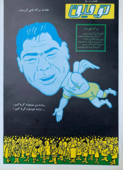Revista semanal política y satírica iraní (1923-1971)
Towfigh, also known as Tawfiq, (Persian: توفیق) was a weekly satirical magazine which was published between 1923 and 1971 in Tehran, Iran, with some interruptions. It was among the critics of the Pahlavi rule.[1]
The journal went through three phases: from 1923 until 1939, under founding editor Hossein Towfigh the magazine was more nationalistic; from 1941 until 1953, under the son Mohammad-Ali Towfigh the magazine was more politically and government-critical; and later versions of the magazine under Towfigh brothers Hassan, Hossein, and Abbas, they focused on pure satire.[2]
History
Towfigh was launched in 1923 and was a four-page weekly.[2][3] However, there are other reports giving its foundation date as 1922.[4][5] The headquarters of the magazine was in Tehran.[3] Its founder was the Iranian journalist Hossein Towfigh who edited the magazine until his death in 1939.[3] During his editorship the magazine ceased publication between 1932 and 1938.[3]
He was succeeded by his son Mohammad Ali Towfigh as editor, who restarted the publication in 1941.[3][6] In 1949 the magazine was banned following the frequent publication of the cartoons mocking Prime Minister Abdolhossein Hazhir.[7] Mohammad Ali Towfigh edited Towfigh until 1953 when the magazine was again closed down by the Iranian authorities after the overthrown of the government of Prime Minister Mohammad Mosaddegh.[3][6]
It was restarted on 20 March 1958 with the title Fokāhi (Persian: Humorous).[3] Later it began to be published under its original title and was edited by three nephews of Hossein Towfigh (named Hassan, Hossein and Abbas Towfigh).[2][3] One of its frequent targets was Prime Minister Amir-Abbas Hoveyda[5] who was instrumental in its closure by the censorship agency in 1971.[8]
Content, contributors and political stance
Towfigh tuvo una postura política cambiante a lo largo de su existencia. Apuntó y expresó las opiniones políticas de los iraníes de clase media y baja. [4] Sus contribuyentes fueron escritores y artistas liberales y seculares. [4] Los principales contribuyentes incluyeron a Abolqasem Halat, Abbas Forat, Iraj Pezeshkzad , Parviz Khatibi, Manouchehr Mahjoubi, Omran Salahi, Manouchehr Ehterami, Kioumars Saberi Foumani , Kambiz Derambakhsh y Naser Pakshir. [6] Hadi Khorsandi comenzó su carrera periodística en la revista en la que colaboraba cuando era estudiante de secundaria. [9]
La revista presentaba caricaturas políticas que aparecieron cinco años después de su inicio, cuando el gobierno iraní permitió su publicación. [3] Estas caricaturas en su mayoría atacaban a los miembros de la dinastía Pahlavi de manera encubierta para evitar la censura. [4] A partir de 1938 la revista comenzó a contener material literario en lugar de sátira política debido a la estricta censura ejercida por el gobierno. [3] Tras la abdicación de Reza Shah en 1941, Towfigh continuó publicando caricaturas políticas y sátiras políticas hasta su cierre en 1971. [3] En estos materiales satíricos, el Shah, Mohammad Reza Pahlavi , los primeros ministros y miembros del gabinete fueron criticados por su supuesta ineficiencia e incompetencia. [7]
Legado
El Proyecto de Microfilmes Persas de Chicago iniciado por la Universidad de Chicago en 1985 archivó los números de Towfigh . [10]
Portadas de remolque
Portada de 1967 (Salnameh Tawfiq)
Portada del 21 de noviembre de 1968 que satiriza al primer ministro Hoveyda, detenido por la mascota de Towfigh, "Kaka Towfigh".
Portada del 14 de enero de 1968 en la que aparece el medallista de oro olímpico iraní
Gholamreza Takhti, después de su muerte, diciéndoles a los dolientes "no lloréis por mí, llorad por vosotros mismos".
Referencias
- ^ گلونی (22 de agosto de 2018). "سخنرانی سید فرید قاسمی در بزرگداشت حسن توفیق". golvani.ir (en persa) . Consultado el 6 de diciembre de 2022 .
- ^ abc Abbas Milani (2008). Persas eminentes: los hombres y mujeres que hicieron el Irán moderno, 1941-1979, volúmenes uno y dos. Nueva York, NY: Syracuse University Press . págs. 406–409. ISBN 978-0-8156-0907-0.
- ^ abcdefghijk Hasan Javadi (2017). "Periódico Towfiq (Tawfiq)". Encyclopædia Iranica .
- ^ abcd Sahar Razavi (2021). "Rocas y lugares difíciles: género, sátira y reproducción social en el Irán prerrevolucionario". Revisión de estudios de Oriente Medio . 55 (1): 72, 84. doi : 10.1017/rms.2021.34 . S2CID 247980019.
- ^ ab Liora Hendelman-Baavur (2019). Creando la mujer iraní moderna. Cultura popular entre dos revoluciones. Cambridge: Prensa de la Universidad de Cambridge. pag. 74.doi : 10.1017 /9781108627993. ISBN 9781108627993. S2CID 211433811.
- ^ abc Mahmud Farjami (2014). "La sátira política como índice de la libertad de prensa: una revisión de la sátira política en la prensa iraní durante la década de 2000". Estudios iraníes . 47 (2): 219–220. doi :10.1080/00210862.2013.860325. S2CID 145067513.
- ^ ab Babak Rahimi (2015). "Culturas satíricas de los públicos de los medios de comunicación en Irán". Gaceta de Comunicación Internacional . 77 (3): 271. doi : 10.1177/1748048514568761. S2CID 144012670.
- ^ Abbas Milani (2004). "Hovayda, Amir-Abbas". Encyclopædia Iranica . vol. XII.
- ^ Hadi Khorsandi (febrero de 1986). "Sadeq Sedaqat de clase 4-D". Índice de Censura . 15 (2): 25–28. doi :10.1080/03064228608534041. S2CID 143127646.
- ^ Laurie Abbott (julio de 1991). "Informe del Proyecto de Microfilmes de Chicago". Boletín de la Asociación de Estudios de Oriente Medio . 25 (1): 36. doi :10.1017/S0026318400023658. JSTOR 23060983. S2CID 164443556.
enlaces externos
 Medios relacionados con Towfiq en Wikimedia Commons
Medios relacionados con Towfiq en Wikimedia Commons



